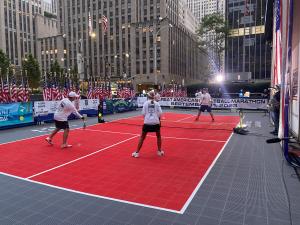As pickleball surges in popularity, a rise in injuries among older players raises concerns over unsafe playing surfaces.
— Thomas Petersen
NEW YORK, NY, UNITED STATES, September 9, 2024 /EINPresswire.com/ — As pickleball continues to grow in popularity across the U.S., concerns are mounting over the rise in injuries associated with the sport, particularly among older adults. NBC News recently reported that pickleball-related injuries, especially bone fractures, have increased significantly, with over 5,400 injuries occurring annually, most affecting players aged 65 and older.
The growing number of injuries is not caused by the game itself but by the surfaces players are using—primarily concrete and asphalt. These hard surfaces, often found in parks and recreational facilities, provide no shock absorption, putting players at risk for severe falls and joint injuries.
Why Playing Surfaces Matter
Concrete and asphalt are notoriously hard, and falls on these surfaces are like hitting a brick wall. According to studies, many players who fall on these unforgiving courts end up in hospitals with fractured hips, wrists, and ankles. These surfaces simply have no give, making them especially hazardous for older players, whose bodies are more vulnerable to injury.
“Concrete is one of the toughest surfaces on the body, especially as players age,” explains Thomas Petersen, President of SportProsUSA. “Sport Court surfaces are designed differently. They absorb impact, cushion falls, and reduce strain on joints, making them a safer option for long-term play.”
The Real Cost of Ignoring the Problem
Ignoring the dangers of hard playing surfaces comes at a high cost—not only to the players but also to facilities. While pickleball is touted as a lifelong sport, playing on unsuitable surfaces can turn this low-impact game into a high-risk activity for older players. The injuries are not just minor inconveniences but can result in months of recovery and rehabilitation.
For facility owners and managers, there is an added risk. Poorly constructed or maintained courts are not only dangerous but can also lead to significant legal and financial consequences. A properly built, well-maintained court minimizes the risk of injury and protects facilities from potential lawsuits.
“As the popularity of pickleball continues to rise, it’s crucial for communities, parks, and private facilities to hire experienced contractors when building their courts,” says Jason A. Plotkin, Esq., CEO and Managing Attorney at The Pinder Plotkin Legal Team. “Proper construction with the right materials and safety standards minimizes the risk of injury and reduces potential liability. A well-built court not only ensures the safety of players but also protects the facility from costly lawsuits, making it an investment in the long-term success of the space.”
Bounce vs. Safety: The Debate
Some pickleball enthusiasts argue that the bounce on sport court surfaces is not the same as on concrete or asphalt. However, modern pickleball-specific sport court surfaces offer nearly the same bounce as traditional hard surfaces while dramatically improving safety.
“Players might feel a slight difference in the bounce,” says Petersen, “but what they’ll really notice is how much better their knees, hips, and ankles feel after a 45-minute game. That shock absorption isn’t just helping the ball bounce—it’s protecting your body.”
When players consider the trade-off between a slightly different bounce and the risk of serious injury, the decision becomes clear. Safer surfaces prevent injuries and prolong a player’s ability to enjoy the sport without frequent trips to the doctor or hospital.
Recommendations for Safer Play
Petersen stresses the importance of making proactive changes to reduce injury risks for older pickleball players. “If you’re over 50 and still playing on concrete, it’s time to rethink your court choice,” he says.
Top Recommendations for Players and Facilities:
1. Switch to Safer Surfaces: Install sport court flooring, which provides shock absorption and reduces the risk of injury.
2. Encourage Proper Techniques: Warming up and learning the right mechanics can help prevent injuries. Dr. Eric Bowman, an orthopedic specialist, emphasizes the importance of proper technique to avoid common pickleball-related injuries.
3. Schedule Regular Health Screenings: Players over 50 should regularly check their bone density and cardiovascular health, especially if there’s a history of osteoporosis or heart conditions.
4. Equip Facilities with AEDs and CPR Training: Facilities hosting older players should have automated external defibrillators (AEDs) readily available and ensure staff and players are trained in CPR. A recent incident in Wisconsin demonstrated the life-saving importance of quick action and proper equipment when a player was resuscitated on the court thanks to an AED.
Conclusion: Safer Surfaces, Safer Play
Pickleball is a sport meant to be enjoyed for years to come, but safety must be prioritized. Concrete and asphalt courts pose significant risks to older players, and facilities must act to reduce these risks by investing in safer surfaces like sport court flooring. The benefits far outweigh the costs, both for player health and facility liability.
About SportProsUSA
SportProsUSA is a leading provider of sport court surfaces that offer safe, and high-performance solutions for a variety of sports. With a focus on player safety and facility success, SportProsUSA works with clients to design and install surfaces that meet the highest standards for safety and quality.
Thomas Petersen
SportProsUSA
email us here
Visit us on social media:
Facebook
X
LinkedIn
Instagram
Legal Disclaimer:
EIN Presswire provides this news content “as is” without warranty of any kind. We do not accept any responsibility or liability
for the accuracy, content, images, videos, licenses, completeness, legality, or reliability of the information contained in this
article. If you have any complaints or copyright issues related to this article, kindly contact the author above.
![]()



